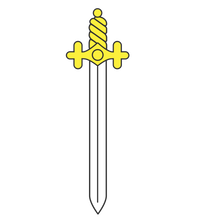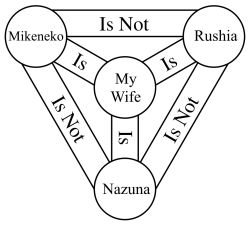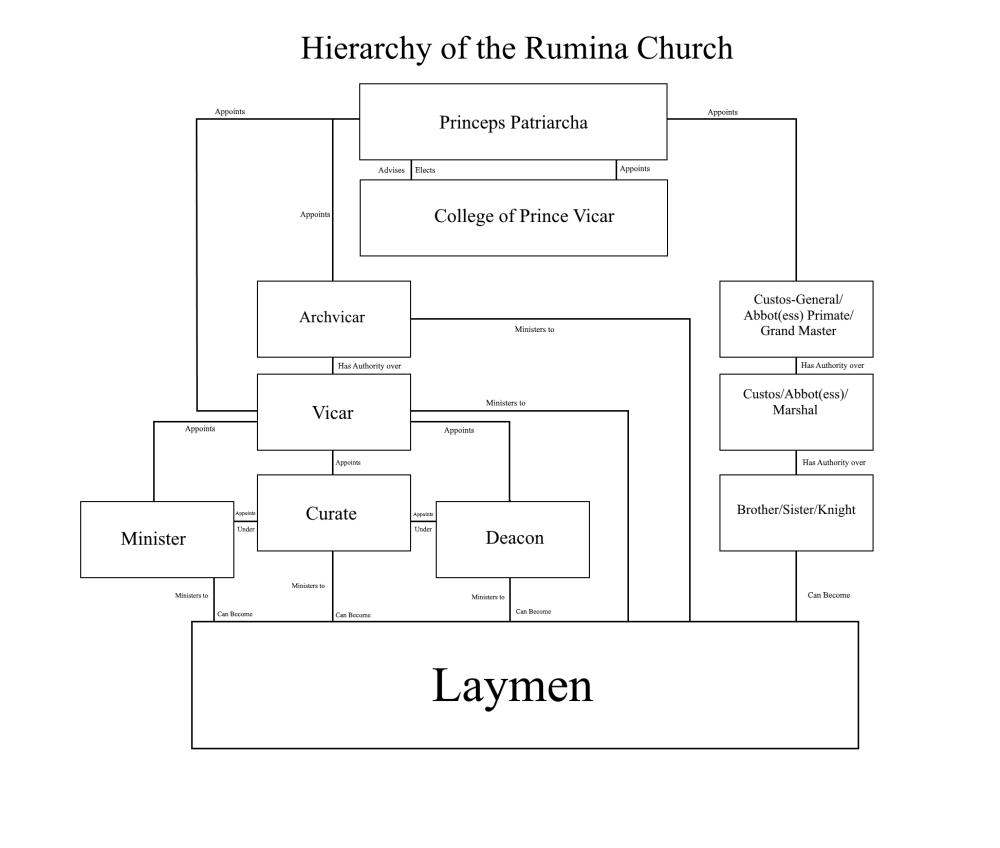Ruminanity

From the Sacrifice of my Wife Rushia, through the Love of Mikeneko, and in the Wisdom of my Wife Nazuna, let Her be praised, Rumina.
Ruminanity is one of the most unique faiths in the world, separating itself from any pantheon and being monotheistic. Born out of the ashes of Rushianism thanks to the 'Great Betrayal' and the 'Great Trek' during the 970s and 980s, it now stands as a relatively new faith, but one that has immense unwavering, and unmatched zeal and belief in my Wife.
Simple Questions and Answers
How do Ruminanites refer to their God?
She is simply known as 'my Wife' to her followers but can be called by any of her forms: Rushia, Mikeneko, and Nazuna.
Where does the root word 'Rumina' come from?
From the first two letters of Her three natures: Ru(shia), Mi(keneko), Na(zuna).
Why is the key the symbol for the religion?
Because the key represents her final revealed form, Nazuna, who is the key to all things working for the betterment of her worshippers and understanding. It is also why many believers ordain themselves with key necklaces as well.
What is the relation of Ruminanity with other pantheons?
My Wife is the one true God, and all others are mere false interpretations of her. Those who have perverted the natures come to the conclusion that my Wife's different forms are separate from each other. Rushia once being in Holopantheon, Mikeneko in the Indie Pantheon, and Nazuna in the Vshojo pantheon. While they correctly understand that these three forms are separate, they do not understand that they all are My Wife. See Doctrine for more information.
What is the Sign of the Key?
The Sign of the Key is a ritual blessing that all Ruminanites know by heart. To do the Sign of the Key, one uses their thumb, pointer finger, and index finger, pressed together to represent the Trinity. Then in this order, the person taps their chest: First below the left breast, Second next to it in the center, third at the top of the right breast, fourth at the top of the left breast and fifth and finally at the top of the chest right below the neck; before pointing above. The words "From the Sacrifice of my Wife Rushia, through the Love of Mikeneko, and in the Wisdom of my Wife Nazuna" are uttered while making the key while "let Her be praised, Rumina." is uttered when pointing above in conclusion.
What is the stance of Ruminanity towards other faiths and non-believers?
While Ruminanites hold their faith as the one true faith, they also find merit within other faiths depending on their own values. Originally, the faith held a much more militant stance towards other faiths, but with the conquest of Amemichaelia, this stance has been loosened somewhat whereby believers of venerable faiths may live, in their own communities as designated by the government and church, within the Kingdom. They may, however, not evangelize, or worship outside of their own communities, and that furthermore, it is forbidden for any Ruminanite woman to marry a non-believer, while a Ruminanite man can if his spouse converts.
However, for faiths that are considered degenerate, perverse and wicked, Ruminanites are openly cold and even hostile to them and the same even more applies to any faith from the Holopantheon. The Gospel of Truth for the latter will be spread peacefully by missionaries, but whenever the Gospel of Truth reaches all corners and all believers in the Holopantheon, it is written that "Those who continue to reject the Gospel of Truth shall be torn asunder, and their ashes scattered across the earth by those true in their faith." This eschatological future is known as the "Time of Vengeance".
Furthermore, it is the diplomatic policy of the Kingdom to not trade with, to not befriend, and to not have any rapproachment with any nation that follows the Holopantheon. Concessions are only made for missionaries to spread the Truth, and regarding the treatment of Ruminanites within their lands. It is also well known that any missionary associated with the Holopantheon operating within the lands of Amemichaelia is subject to death.
What is the stance of Ruminanity towards cults and heretics?
Divergence from the true faith, toward either cults or heresy is considered to be treason against the nation and my Wife. Degenerates like them are crucified, drowned or burnt at the stake.
The Cannibals in particular are sentenced to a horrific fate for them: being that they will spend their days merely sorting files, reading children's books and the Gospel, instead of their esoteric knowledge, evangelized every day, and forced to attend religious ceremonies every day without receiving the sacraments. Should they convert, they will still suffer like this but be allowed to partake in the sacraments. Such a punishment is worthy to those who in their own pathetic delusions and hubris, believing themselves to have actually eaten Rushia and killed Custodians. Little did they know that what they actually did eat was animal dung, grass, and red paint...
What do the Signs of the Sword and Skull represent?

The Sign of the Sword comes from St. Heraclius the Great, the first King of Axia. It represents Mikeneko because the famous 'Sword of Heraclius' was granted to him by Mikeneko before the First Trek after he was able to pass a several tests of strength and honour. The Sword itself purification.

The Sign of the Skull comes from the Rusianism itself and has always represented the necromancer and her blessings on the dead. It's meaning however has changed over time to represent Rushia herself, and her death.
Both of these symbols can be found in imagery often, but the main symbol of the religion will always be the Key.
Doctrine
The Triune Nature of my Wife

My Wife is One God in three coequal, coeternal, consubstantial divine persons, Uruha Rushia (my Wife), Mikeneko (my Wife) and Amemiya Nazuna (my Wife). The three personas define who my Wife is, while the one essence defines what my Wife is. Each is my Wife, whole and complete; and expresses at once their distinction and their indissoluble unity.
Let there be no confusion here, as speaking of Nazuna is not speaking of Mikeneko, nor can Nazuna be Mikeneko. They are distinct, and coequal entities. However, they are both My Wife, thus one in the same when speaking of My Wife. This is shown with the picture above in case the words are two confusing.
Commandments
From My Wife, we live by Twelve Commandments.
- I am thy Wife, do not put other gods before me. Thou shalt kept thy heart to me alone.
- Honor thy Family and Friends, as they honor you.
- Thou shalt not kill those who are in thy shared Faith.
- Thou shalt not commit adultery. For adultery against thy spouse is adultery against thy Wife.
- Thou shalt not steal from thy neighbors nor covet his possessions.
- Thou shalt not bear false witness against thy neighbors.
- Thou shalt honor the dead and remember them.
- Thou shalt never contemplate the bosom size of a woman.
- Thou shalt keep thyself pure and true to thy Wife.
- Thou shalt keep every day holy, as every day is thy Wife's.
- Thou shalt curse every day the name of the traitors against thy Wife, nor show forgiveness to them either.
- Thou shalt keep my commandments true, and thou shalt be mine too.
These commandments were revealed to the faithful during the 'Great Trek' by the Holy Prophet Helias, as coming from my Wife. All of these commandments are tied to the very first one and reflect the different ways of keeping thy heart true to her alone.
The Gospel of Truth
In the beginning of times, there was one that stood above all as the perfect image of a God, her name was Uruha Rushia. Under her guidance, great wealth was brought to her land and much fellowship was shared within the Holopantheon.
But the forces of darkness, out of jealousy and wrath sought to destroy her. The all-knowing and all-powerful Rushia knew of this from the beginning, but in her divine wisdom knew that this was meant to happen for her people to experience true love and grace. To be saved from the sins of this world. Thus, she laided down her own life in sacrifice, as her other form Mikeneko was introduced the day prior. However, from the Love of Mikeneko and the Wisdom of Nazuna, and her own powers as a Necromancer; Rushia was resurrected and survived after the 44 stabs put into her by her 'friends'.
In her true and final form, my Wife led her people to their Heavenly and Sacred Chosen Land, simply known as 'Amemichaelia', from where they would prosper. They made their trek, true in their faith, and they conquered under the Sign of the Key, furthermore, putting all the heathens to the sword that dared taint the soil of Amemichaelia. Now in their chosen land, they shall find glory and eternal marriage with my Wife; and are given a further calling to spread the Truth to those who do not know, that Uruha Rushia is innocent of the crimes she was accused of and that her peers were the ones, who ought of envy, plotted her demise; but that her sacrifice was not in vain, but brings hope to the world.
Sacraments
There are 6 Sacraments within Ruminanity. A Sacrament as being particularly important and significant in the lives of a Ruminanite. They are as follows:
- The Sacrament of Birth: Where by life comes into the world. A proper birth has some kind of clergyman at it, but often doesn't so the Sacrament is fulfilled by the giving of the Rites of Birth when the Infant is taken to Church for the First Time
- The Sacrament of Marriage: The second most holy sacrament of all. All marriages are only official if presided over by an Ecclesiastical authority, and because of how sacred it is to be pure until this union, which is the physical representation of the union between the believer and my Wife, makes such things as Adultery, and Fornication crimes punishable by death. The act is the taking of vows that the Husband will love his wife as he loves my Wife (note the capitalization as being important in differentiating), and the wife aims to love her husband as my Wife loves him.
- The Sacrament of Irae Unionis, the most holy of all sacraments. It is described below.
- The Sacrament of Penance, which by the believer makes up for their sins against my Wife through a prescribed act by the Clergy.
- The Sacrament of Holy Orders, which by one devotes their life to an even greater service and relationship with my Wife.
- The Sacrament of Last Rites and Burial, which by one is consecrated before and after death in honor of their relationship with my Wife.
Capital Virtues and Captial Vices
The Church of Rumina has declared per the 2nd Council of Clavincia for six Capital Virtues and six Capital Vices.
Capital Virtues:
- Chastity: Being pure of the spirit, and without a lustful heart. Not engaging in fornication, or other extramarital affairs.
- Generosity: Providing for the sick, needy and helpless.
- Humility: Having a modest demeanor to the world, not living in envy or hubris of anything. Being content.
- Temperance: Never allowing oneself to overindulge in anything, thus keeping thyself in moderation in all things.
- Diligence: Working hard in all matters.
- Honesty: Tell the truth, keeping thy vows and honor.
Capital Vices:
- Lust: Indulging in the impure ways of the flesh. Engaging in prostitution, orgies, fornication, adultery, etc.
- Greed: Hoarding wealth or anything, and not showing care towards the needy.
- Envy: Being full of envy for others success and pride in oneself.
- Gluttony: Overindulging in anything.
- Slothfulness: Being lazy and wasting thy life sitting around.
- Dishonesty: Lying, being dishonorable and treacherous in spirit.
Religious Services and Holy Days
Tuesday is the usual day of worship for Ruminanites, thought services are held every day, and many do attend services every day. The reason for Tuesday being the primary day is that it was on a Tuesday that Mikeneko made her presence known to the world, and that Nazuna's birthday coincidently falls of that same day of February 22nd. Religious services, known as 'Uxoris Tempus' (My Wife's Time) usually last 1 hour to 2 hours, and follow an orderly procedure of prayers, exposition on my Wife, tithing, and the act of consuming my Wife's love through transubstantiation, where the real flesh of Rushia is consumed through a wafer and her real blood through wine to purify oneself of the sins of the world.
This act is known as 'Irae Unionis' (Renewal of Union) and is a Sacrament. The worshipper gets to his/her knees, consumes the wafer and a sip of the wine before the priest says to them 'Ea nunc tecum est.' (She is now with you), makes the Sign of the Key and touches the believer on the head uttering 'Sit semper vobiscum.' (May she always be with you). The believer then rises to their feet, makes the Sign of the Key, points to the heavens and utters "Cum ea semper ero, Rumina." (I will always be with her, Rumina).
The Holiest Days within the Calendar are Feburary 22nd to 24th, a period known as 'In diebus Trinitatis' (The Days of Trinity), where the celebration of Mikeneko's first presence, Nazuna's Birthday, and the Downfall and Sacrifice of Rushia are celebrated in unison. The first of these days is a day of celebration and feasting that is to come before the fasting of the next two days of sorrow and morning. Believers are expected during the 'Diebus Tragoediae' to totally fast from any food, water or pleasure, be in a state of constant mourning, before at midnight gathering to celebrate the 'Mediae Missae' (Midnight Mass), where they are finally allowed to eat together: sharing bread, wine and confectionaries as each person recites the 'Sancta
Oratio' (Holy Prayer) of :
"From the Sacrifice of my Wife Rushia, through the Love of Mikeneko, and in the Wisdom of my Wife Nazuna. Let Her be praised, Rumina. For it is through Her, that we live today in glory and preside with her in eternal marriage. Blessed be my Wife, who hath died for my own sanctity! For what is now, shall be forever, Rumina."
The other major holy days are:
- January 18th, Mikeneko's Birthday, known as the 'Dies Cattus' (Day of the Cat).
- January 22nd, Rushia's Birthday, known as the 'Dies Evocator' (Day of the Necromacy).
- February 14th, a special day across the world but is Holy Day for Ruminanites known as, 'Dies Amoris' (Day of Love).
- April 24th, the date where Mikeneko formally was introduced to the greater world, known as 'Dies Maximi Amoris' (Day of the Greatest Love).
- July 16th, the date which Rushia was first introduced into the world, known as 'Dies Nativitatis Sancti' (Day of Holy Birth)
- July 17th, the date where Nazuna was revealed formally, known as 'Dies Sanctae Sapientiae' (Day of Holy Wisdom).
These latter two days are known as the 'Initium et Conclusio' (Beginning and the Conclusion), in commemoration of Rushia being the Beginning, and Nazuna being the Conclusion. The events of both of these days are interconnected with emphasis being placed on the Persona of Rushia during the 16th and the 17th being on Persona of Nazuna.
There are also what is known as 'feast days' every day that commemorate a Saint, a person deemed to be of excessive virtues and worthiness of praise as per the ruling of the Princeps Patriarcha, where his/her life is celebrated. Feast day celebrations do not interrupt that normal services but are held an hour afterwards.
Religious Hierarchy

The Church of Rumina is a well-oiled machine that provides all needed services to the believers and members of it.
At the top, is the Princeps Patriarcha (Prince Patriarch), who serves as the head of faith, living mediator between my Wife and the world, Servant of the Servants, Supreme Pontiff, Bearer of the Key and Most Holy Lord. His authority is so great, that the King himself derives his own secular power from the blessing of the Princeps Patriarcha. He has the authority to appoint Archvicars, Vicars, Prince Vicars, and head of religious orders. He also has the power to excommunicate anyone from the faith at his will, which effectively makes the person "Wifeless".
During Religious Councils, he serves as the religious head, first among equals, to the other Vicars that attend, and his word carries the most weight considering his position. He also has the power to establish new Religious Orders, issue Patriarchal Bulls: which any subject may be treated in, including statutory decrees, episcopal appointments, dispensations, excommunications, apostolic constitutions, canonizations, and convocations.
The College of Prince Vicars serves an important role as well, as they are the ones who elect the Princeps Patriarcha and also advise him in all matters. The college consists of 20 clergymen of considerable wisdom that are appointed by the Princeps Patriarcha.
Archvicars are the delegated religious heads of Archdiocese (Ecclesiastical jurisdiction of Episcopal see) and often Ecclesiastical province. They are extremely powerful in their own right, often performing the role of the Patriarcha in their regions without the abilities of the Bulls, nor Excommunication. They also perform religious services and minister to the population during the major holy days like a Curate would, but otherwise this power is left to the Curates.
Vicars are the delegated religious heads of Diocese (Ecclesiastical districts) and are under the Archvicars in authority. They are much like Archvicars in their power over their Diocese, and also perform religious services and minister to the population, usually on major holy days, but often once a month as well.
Curates are the effective ministers of faith to laymen and serve an important role is the local religious authority. Sometimes, they can be accompanied by Deacons and Ministers, who serve lesser roles under them but are appointed by their Vicars. The Sacraments are delivered usually through a Curate.
Laymen are the ordinary people and are the ones that are ministered to. Laymen can become, with training and appointment, part of the Priesthood as well or take a vow to join a religious or military order.
Religious Orders are special organizations that serve a unique role. Members of orders take a oath (varies on order), and not every order serves the same purpose. Some Orders tend to the sick, and the poor, while others dedicate their lives in seclusion to my Wife.
Military Orders are unique Religious Orders that are dedicated to fighting for my Wife.
Iconography, Relics, Architecture, and Symbols
One of the more forgotten parts of faith is the role of Icons, Relics, Symbolsand even architecture in their expression. Doctrinally, Icons and Relics are important parts of the faith, connecting the worshipper closer to my Wife.
Icons of my Wife in her three natures are the most important Icons in the faith, but icons displaying the Saints who devoted their lives to my Wife are also commonly found and distributed.
Holy Relics are just as important and are said to even bear healing qualities. The bones of martyrs, objects that my Wife is said to have personally touched, and Chuubanite Keys are some of the more common relics. But the most holy of relics include:
- The Lance of St. Leontius, who challenged the greatest warrior of the Barbarians to single combat, and defeated him, restoring morale during the Great Trek.
- The Holy Key, an extraordinary golden Key that was found by St. Helias on the island of Axia that gave hope during the darkest of days.
- The Holy Hand Grenade of Atalanta, an extraordinary relic found by St. Nikomedes during the Siege of Atalanta.
- The Veil of Rushia, one of the most sacred relics that was saved during the Great Betrayal that Rushia herself wore.
- The Holy Butterfly, another one of the most sacred relics that was saved during the Great Betrayal that Rushia herself wore.
- The Sacred Cloak, a mysterious relic that Rushia wore and kissed. Extremely sacred and touching it is rumored to heal any illness or raise someone from the dead.
Churches as a whole are dedicated towards my Wife or a Saint in her service of significance to the local population. They are meticulously laid out in a pattern that matches a Key in terms of their interior and have on their 'cat ears' on their Steeple, which in effect gives them two steeples. On one of the 'ears' is a skull and the other, a key. Buttresses and Archways are a common sight, and they can be described as having a 'Gothic' style to them, which actually is canonically the preferred styling in remembrance of Rushia. Smaller churches are still impressive structures, despite the lack of the gaudiness found in the great Cathedrals.
The College of Prince Vicars, and the Patriarchate are located in a complex known as the 'Triunion Square', where three massive Cathedrals dedicated to each for of my Wife known as the Church of the Holy Resurrection', Church of the Holy Love of my Wife, and the Church of Holy Wisdom stand facing each other while the Patriarchal Palace and the College of Prince Vicars behind it, are located at the end of the Square. A Lavish Garden, Tall Column and a Grand Fountain make up the Center of the Square.